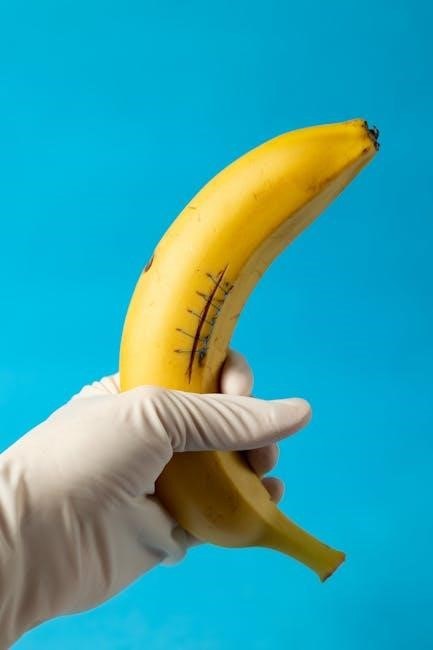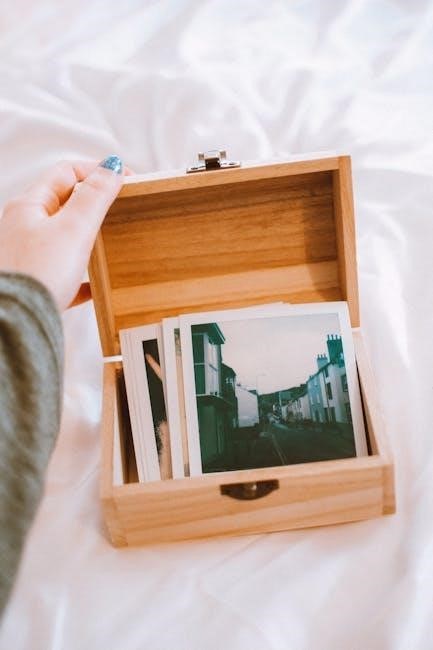Hand stitches are fundamental techniques in sewing and embroidery, offering versatility for both practical and decorative purposes. Common stitches include running stitch, backstitch, and blanket stitch, each serving unique functions in crafting and repair. These stitches are essential for beginners and experts alike, providing a foundation for various textile projects.
Overview of Common Hand Stitches
Hand stitches are essential techniques in sewing and embroidery, offering a wide range of options for various projects. Common stitches include the running stitch, ideal for beginners, and the backstitch, known for its strength. The blanket stitch is perfect for finishing raw edges, while the chain stitch and satin stitch are popular for decorative embroidery. Advanced stitches like the buttonhole stitch and herringbone stitch provide intricate detailing. These stitches are categorized into basic, surface embroidery, and advanced types, each serving unique purposes in crafting, repair, and artistic expression. Understanding these stitches enhances creativity and precision in textile projects.
Importance of Learning Hand Stitches
Mastering hand stitches is essential for any sewer or embroiderer, providing a strong foundation for various projects. These stitches enhance creativity and precision, allowing for both functional repairs and decorative embellishments. From the simple running stitch to the intricate herringbone stitch, each stitch offers unique versatility. They are invaluable for hemming, seaming, and quilting, making them a crucial skill for textile enthusiasts. Additionally, hand stitches preserve traditional craftsmanship and open up endless possibilities for personal expression. With numerous resources like books and online guides available, learning these stitches is more accessible than ever, ensuring their techniques endure.

Basic Hand Stitches
Basic hand stitches are essential for sewing projects, offering foundational techniques for repairs and creations. They include the running stitch, backstitch, and basting stitch, each serving unique purposes in crafting and mending fabrics with precision and simplicity.
Running Stitch
The running stitch is the most basic and versatile hand stitch, ideal for beginners. It involves making small, straight stitches in a consistent rhythm, moving the needle forward with each step. This stitch is commonly used for gathering fabric, basting, or creating simple outlines in embroidery. Its simplicity makes it a go-to for various projects, from repairing seams to decorative stitching. Detailed guides and images in PDFs demonstrate its technique, ensuring easy mastery for sewists of all skill levels, making it an indispensable tool in both practical and creative sewing tasks.
Backstitch
The backstitch is a strong, reversible stitch often used for outlining designs in embroidery or sewing. It is created by making small backward stitches, ensuring a secure and visible line. This stitch is particularly useful for text embroidery, decorative borders, and sewing on buttons. Its durability makes it ideal for areas requiring strength, like seams in heavy fabrics. Step-by-step guides and images in PDFs provide clear instructions, making it easier to master. Whether for practical repairs or artistic embroidery, the backstitch is a reliable choice for achieving clean, defined lines in various sewing projects.
Basting Stitch
The basting stitch is a temporary, long, and loose stitch used to hold fabric layers together before permanent sewing. It is easily removable and ideal for quilting, appliqué, or fitting garments. This stitch ensures fabric stays aligned without damage, allowing for precise adjustments. Step-by-step guides and images in PDFs demonstrate its simple technique, making it accessible for beginners. Its primary purpose is to provide stability during complex sewing processes, ensuring accuracy and ease in subsequent stitching. Whether for home sewing or professional tailoring, the basting stitch is an essential preparatory tool for achieving flawless results.

Surface Embroidery Stitches
Surface embroidery stitches enhance fabric with intricate patterns and texture. Common stitches include blanket stitch, chain stitch, and satin stitch, often detailed in PDF guides with images for clarity.
Blanket Stitch
The blanket stitch is a versatile surface embroidery stitch often used to finish raw edges or create decorative borders. It is particularly popular for baby blankets, hence its name. Typically worked from left to right, the stitch involves inserting the needle at a slight angle to create a series of small, even loops. PDF guides frequently include step-by-step visuals to master this stitch. It’s ideal for fabrics like fleece or wool and is also used in appliqué to secure edges. The blanket stitch is a must-learn for both beginners and experienced embroiderers.
Chain Stitch
The chain stitch is a foundation embroidery stitch that forms a continuous loop, resembling a chain. It is commonly used for outlining designs and creating straight or curved lines. Easy to learn, this stitch is ideal for beginners. PDF guides often illustrate its simple process, making it accessible. The chain stitch is versatile, suitable for various fabrics and projects, from delicate linens to sturdy canvases. It’s also used in quilting and appliqué. With practice, embroiderers can achieve smooth, consistent loops, making this stitch a staple in many hand embroidery kits and patterns.
Satin Stitch
The satin stitch is a popular embroidery stitch used to fill large areas with a smooth, shiny surface. It consists of long, straight stitches worked parallel to one another, creating a lustrous, satin-like appearance. Ideal for filling shapes like leaves, flowers, and backgrounds, it is often used in decorative embroidery. To achieve even stitching, maintain consistent tension and spacing. The stitch is versatile, suitable for various fabrics and projects. PDF guides often provide step-by-step visuals, making it easier to master. With practice, embroiderers can create flawless satin stitch designs, enhancing their embroidery projects with elegance and precision.
Advanced Hand Stitches
Advanced hand stitches, like the buttonhole stitch and pad stitch, are intricate techniques offering durability and precision. They are ideal for tailored finishes, reinforcing seams, and creating decorative details in high-end garments and textiles.

Buttonhole Stitch
The buttonhole stitch is a sturdy, versatile hand stitch primarily used to reinforce buttonholes in garments. It creates a secure, flexible edge that prevents fabric from fraying. This stitch is also ideal for decorative purposes, such as embellishing seams or creating textured elements in embroidery. To execute the buttonhole stitch, bring the needle up on one side of the intended hole, loop the thread around the edge, and insert the needle back into the fabric on the opposite side. Repeat this process, maintaining even spacing for a polished finish. It’s a must-learn for both functional and decorative sewing projects.
Herringbone Stitch
The herringbone stitch is a strong, reversible hand stitch ideal for seaming and decorative purposes. It creates a chevron-like pattern by working two diagonal stitches in opposite directions. This stitch is particularly useful for heavy fabrics and is often employed in tailoring to join thick materials seamlessly. It is also used in embroidery for textured, decorative elements. The herringbone stitch is worked by inserting the needle diagonally forward and backward in a zigzag motion, ensuring even tension for a professional finish. Its durability and aesthetic appeal make it a popular choice for both functional and artistic stitching projects.
Pad Stitch
The pad stitch is a specialized hand stitch primarily used in tailoring to create structure and shape, particularly in areas like shoulders and collars. It involves small, even stitches worked over a layer of interfacing or stabilizing material. This stitch is essential for creating a smooth, padded surface without bulk, ensuring a polished finish. The pad stitch is worked by inserting the needle vertically and making small, consistent loops, anchoring the fabric layers firmly. Its application is crucial in high-end tailoring for achieving a professional, tailored look in garments that require shape and stability.

Uses of Hand Stitches
Hand stitches are versatile, serving both practical and creative purposes. They are used for hemming, seaming, decorative embroidery, quilting, and tailoring, enhancing functionality and aesthetic design in textiles.
Hemming and Seaming
Hemming and seaming are essential techniques in sewing, often completed using hand stitches. Hemming involves folding fabric edges to prevent fraying, while seaming joins fabric pieces together. The running stitch and slip stitch are commonly used for these tasks. Hemming ensures a clean finish on garments and home textiles, enhancing durability. Seaming, particularly with the whip stitch, is ideal for invisible joins in projects like stuffed animals or pillows. These stitches are fundamental for both functional and decorative applications, providing a professional finish to sewing projects.
Decorative Embroidery
Decorative embroidery is a traditional art form that enhances fabrics with intricate designs and patterns. Common hand stitches like the satin stitch, chain stitch, and herringbone stitch are frequently used to create visually appealing designs. These stitches allow for creativity and precision, making them ideal for embellishing clothing, linens, and home decor. The satin stitch is perfect for filling large areas, while the chain stitch excels at outlining and detailing. Decorative embroidery adds a personal touch to projects, offering endless possibilities for artistic expression and aesthetic appeal.
Quilting and Appliqué
Quilting and appliqué rely heavily on hand stitches to create intricate designs and secure fabric layers. The running stitch is often used for piecing quilts, while the slip stitch is ideal for attaching appliqué without visible threads. These techniques allow for precision and artistry, making hand stitches indispensable in quilting projects. Appliqué, in particular, benefits from stitches like the blanket stitch, which finishes raw edges and prevents fraying. Quilting and appliqué combine functionality with creativity, showcasing how hand stitches can transform fabric into beautiful, lasting works of art.

Resources for Learning Hand Stitches
Numerous resources are available to learn hand stitches, including books like Picture Dictionary of Hand Embroidery Stitches, online tutorials, and PDF guides with step-by-step photos and patterns, ideal for all skill levels.
Books on Hand Embroidery
Books on hand embroidery are invaluable resources for learning various stitches and techniques. Titles like Picture Dictionary of Hand Embroidery Stitches by Juby Aleyas Koll Sarah offer detailed visual guides and traditional embroidery insights. Another notable book provides step-by-step photographic illustrations, covering 300 hand embroidery stitches with tips and patterns. These books cater to all skill levels, from beginners to experienced embroiderers, and are perfect for mastering stitches like the running stitch, blanket stitch, and more. They often include project ideas, making them comprehensive tools for both learning and creating beautiful embroidery pieces.
Online Tutorials and Guides
Online tutorials and guides are excellent resources for mastering hand stitches. Websites and platforms like YouTube offer step-by-step videos and detailed instructions for stitches such as the running stitch, backstitch, and blanket stitch. Many online guides include high-quality images and patterns, making it easier to learn complex techniques. Additionally, blogs and crafting websites provide tips, tricks, and projects that help practitioners improve their skills. These resources are accessible to everyone, from beginners to advanced embroiderers, and allow learners to progress at their own pace. They are a great supplement to books and PDF guides, offering interactive and visual learning experiences.
PDF Guides and Patterns
PDF guides and patterns are invaluable resources for learning hand stitches. Many downloadable guides feature step-by-step instructions, high-quality images, and detailed diagrams, making complex stitches easier to master. These resources often include patterns for various projects, from simple embroidery to intricate quilting designs. PDFs are particularly useful for their portability and accessibility, allowing learners to practice anywhere. They frequently cover a wide range of stitches, such as the running stitch and blanket stitch, with visual aids to ensure clarity. Whether you’re a beginner or an advanced sewer, PDF guides provide a comprehensive and convenient learning experience.
